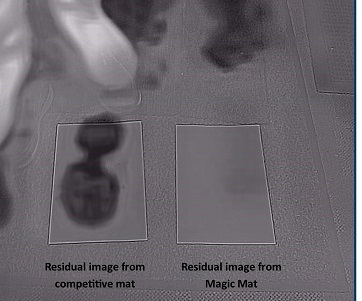
Another view of our ‘walk-off’ demonstration
At a recent trade show in our nation’s capital, another exhibitor was watching our famous walk-off demonstration where we compare our Magic Mat against several competitive mats by walking through a tray of mud then across each mat and then on to clean white paper.
Typically, we get a lot of surprised responses when we do this demonstration, because the difference between our mat and our competitors mats is remarkable. There is virtually no residue left on the paper from our mats, but a significant muddy print left behind on the competitor mats.
This other exhibitor had a ‘FLIR’ attachment on his phone that allowed him to film thermal traces that are invisible to the naked eye. It shows heat signatures, just like police and military use to find people in the dark.
This image shows the walk-off demonstration from the point of view of a thermal footprint. The ghostly image clearly shows no residual imprint remaining from the Magic Mat side, but a distinct print remaining from the competitor mat.
This proves just how much of a difference that can and can’t be seen when you choose the right matting for your home of work. Mats are supposed to stop the spread of what’s outside from coming inside. Only Rismat mats stop the spread this effectively.
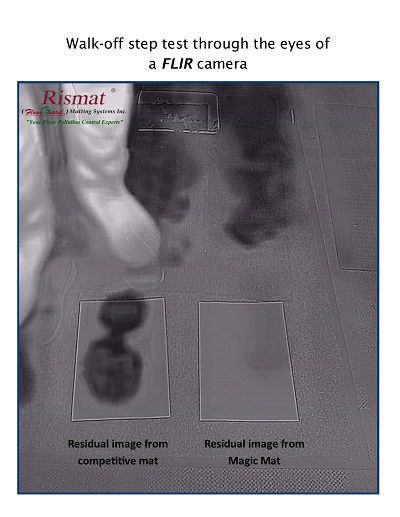
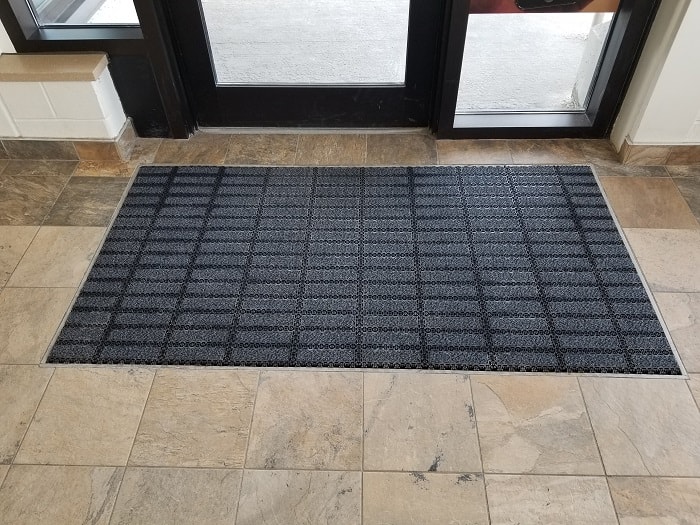
Loving and Hating your Mat Well Grates
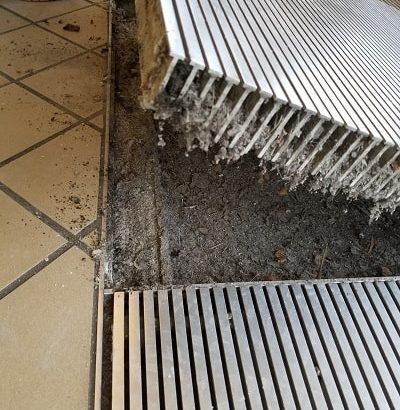
Mat wells may not be regularly maintained simply because it can be very difficult to remove the heavy metal grating, or it has corroded in to the side walls and requires specialized tools to access, and the dirt is often hidden below the grates, out of sight and mind.
When neglected, mat wells can begin to degrade beneath the surface, eventually collapsing or causing structural damage to the entrance area. This is typically due to a build up of salt residue combined with moisture, promoting accelerated metal corrosion and concrete deterioration.
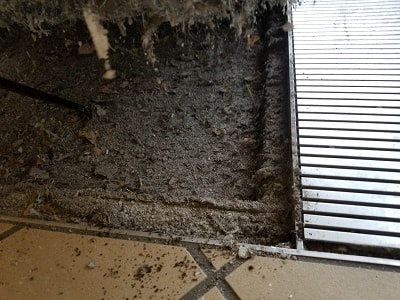
A thorough cleaning of mat wells twice per year – spring and fall – along with a comprehensive inspection of their condition will help extend the life and functionality of the well.
Using a vacuum system, remove all the loose dust and debris, then gently scape out the built-up salt and dirt residue, while wearing protective eye wear and an appropriate face mask. Once complete, rinse the well using a neutralizer, then dry it completely before replacing the grating. Don’t forget to also clean the surface grating system with a scrub tool or a pressure wash system.
We recommend applying a waterproofing membrane to the clean mat well, which will protect the structure from water and salt damage and extend the life of the well.
One of the least observed or appreciated tools your facility has in the battle of cleanliness is the under-rated and often loathed mat well grating system.
Lately, we have seen a huge growth in addressing problems with mat wells in buildings and in public transit locations.
Mat wells are often designed with a shallow tray of aluminum or concrete with a scrub grating placed on top, designed to capture the dirt and moisture that gets tracked into buildings.
Sometimes, they have a deep tray or even a drain grate in the bottom to allow for cleaning or for the excess water to be collected.
Typically, these wells are often ignored; either because we don’t think about them very much, or because the dirt collected under them is disgusting to look at, smell, or touch. That’s exactly what a mat well is for – catching and holding all the dirt and moisture that would otherwise be tracked in to the building.
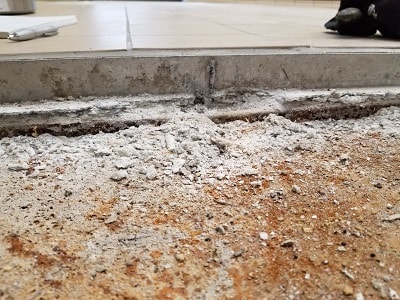
Once this level of degradation occurs, the well may require costly removal and replacement, and create a hazard for unaware pedestrians.
The residual debris in these wells can also develop mold and other respiratory issues for people using these facilities and promoting the spread of harmful airborne pollutants.
The good news is that with proper maintenance and the right grating system in place, mat wells can be a very effective way to reduce the spread of floor pollution into a facility, and act as a trap for larger particles that can damage your floors.
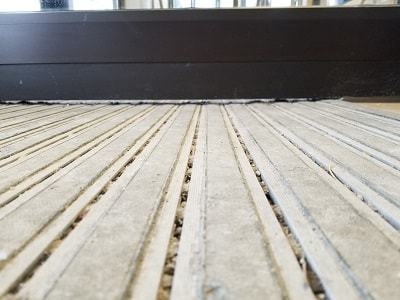
This is also a good time to look at the condition of the surface of the grating to ensure that it is not worn or damaged. This is the time to look at replacing the aluminum or pedi-grid style material for something that is easier to work with and offers a better cleaning surface.
Aluminum grating systems are rugged, but can corrode, are heavy and expensive to install and replace, and can create their own slip-hazards when wet. A proper scrubbing material that is more resistant to corrosion and is light-weight and easy to clean is worth looking in to.
When properly serviced and maintained, and the correct surface materials are installed, mat wells offer a clean, secure and effective cleaning service, 24/7.
Viking for Mat Wells
Viking Mat Well Grate replacement
Building entrance mat well grates are a common sight in Canada, but for property managers, they are often a messy, unsightly and challenging feature to deal with.
Most mat wells consist of a shallow tray covered in a metal grating system, designed to catch dirt and moisture before it can travel into the facility.
Unfortunately, most mat wells use ineffective and expensive grating systems that wear out and look terrible, leaving a disappointing first impression when people enter the building.
Aluminum grate systems can be difficult to work with. Because they are usually one or two pieces, they are extremely heavy and cumbersome, so most facility managers don’t bother cleaning them out regularly. This can lead to a build up of corrosive salt residue, warping and damaging the grating and eventually degrading the concrete base.
Aluminum grating is very expensive and requires professional installation, so replacement plans are often put off well past the life-span of the grates. Even if a small section of the grating is worn out, the entire grate system must be replaced.
From a user perspective, aluminum grating can become very slippery when wet, is a poor scrubber and is generally noisy and unattractive.
Rismat’s modular, UV and corrosion-resistant PVC scrub tile system is quickly becoming the most popular replacement system for mat wells.
The 8” square tiles lock together, creating a seamless, comfortable and effective scrub system that is easy to install, remove, clean, and replace. Since each tile can be easily disconnected, worn out sections can be replaced individually, saving thousands of dollars over the life of the product.
The Nylon brush inserts on our Viking tiles offer a superior scrub action, while the open channel pattern allows moisture to dissipate into the grate.
Real-world testing has shown our Viking tiles can withstand foot traffic beyond 50 million people and still offer a superior, comfortable and safe solution.
Our scrub tiles can be surface mounted with added beveled edging or fitted into any size of mat well easily, and is the choice for many apartments buildings, public attractions and transit systems.
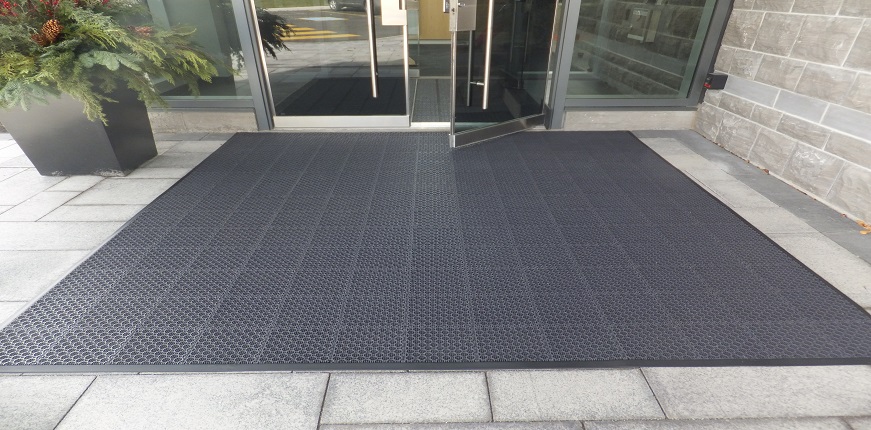
Making the Most of your Mats
MAKING THE MOST OF YOUR MATTING SYSTEM
There is more to effective matting than simply putting mats at the doorway. A proper system with the right product can reduce the transmission of dirt, moisture and debris by 80% or more.
Before placing any mat on the floor, ensure the surface area is clean and dry. What sits below the mat will affect its ability to protect the floor and reduce damage and slipping.
For optimal performance from your entrance mat, it should be long enough for pedestrians to take a minimum of 3 full steps on them before walking off (3 steps on each foot). This allows the matting enough time to pick up loose dirt and moisture.
Matting should be looked at in 3 segments – the ‘primary mat’, meaning the first mat, usually a scrub type mat that pedestrians cross, the ‘secondary mat’, the typical entrance mat, just inside the door, and the ‘specialty’ or transitional mats for interior areas that develop debris.
A primary scrub mat directly before your entrance door, outside or in mat wells, can reduce the load of debris crossing the threshold by up to 40%. Scrub mats grab loose grit, salt and larger debris, and some moisture. Avoid solid rubber scrub mats outside as they can hold moisture between the mat and the ground causing damage and creating an unpleasant odour. Rubber can also wear out prematurely, particularly in harsh weather. For this purpose, a good quality PVC system that allows moisture to channel away is a much better choice.
A secondary, or entrance mat, should be as absorbent as possible. To quickly find out if your current mats are absorbent and working properly, do the water test: Step in a small amount of water – just enough to cover the soles of the shoes – then wipe your wet shoe on the mat 3 or 4 times. When done, step on a clean piece of paper. If a shoe print is clearly visible on the paper, the mat is not absorbent and will allow moisture to transmit past it.
Slowing foot traffic down through the entrance way is also a great way to get the most effective use of your entrance matting.
- Where there are two sets of doors, try to offset the access so that pedestrians have to zig-zag in. This gives them more time on mats in the vestibule areas and allows the mats more time and more steps to catch and absorb debris. This also reduces wind-flow through the vestibule area, saving on heating costs
- Create a ‘calming’ zone by adding a plant feature or some other object that slows down or diverts the pace at which people walk. Slower steps means more steps on the mats. This technique is often used in retail stores about 8’ – 10’ inside the doors to get people to slow down and shop/browse by use of a feature table or sale sign.
Keep doors closed as much as possible—especially in the colder months. This slows pedestrians down and helps to maintain ambient temperatures in lobby and common areas. In the summer, it helps reduce dust and dirt from blowing in. Dust, dirt and sand can cause significant damage to your floors as they act like sandpaper on the bottom of shoes. Many facilities remove most of their matting in the warmer months, exposing the floor surfaces to this abrasive damage.
Air-borne dust that settles on products, furniture and sensitive electronic equipment can be tracked back to floor dust that is tracked in then ‘blown’ into the air due to a lack of effective matting to hold it down. Because of this, avoid cleaning equipment like brooms or vacuums that use aggressive scrubbers. Warm water extraction is the best and safest way to reduce the spread of air-borne dust. Also, use a mat that has good static-electricity characteristics, particularly tufted fabrics like microfiber that act like a dust magnet.
For interior transitional zones, specialized matting is key in debris transmission and floor protection but is often overlooked. Parking garages and side entrances sometimes get more traffic than main entrances, and are often the culprit in the spread of dirt. Social rooms, gymnasiums and pool areas are also common areas where debris gets transferred through buildings.
Washroom areas, particularly in restaurants are a leading contributor of germs and debris. Washroom matting at urinals, hand dryers and sink areas not only slow the spread of contaminated moisture from foot traffic, they provide a safe, slip preventative protection for patrons.
Also, don’t forget about mechanical areas such as escalators and elevators. A mat just before these can help reduce expensive repair and maintenance costs by catching debris and preventing it from becoming entangled in gears and motors.
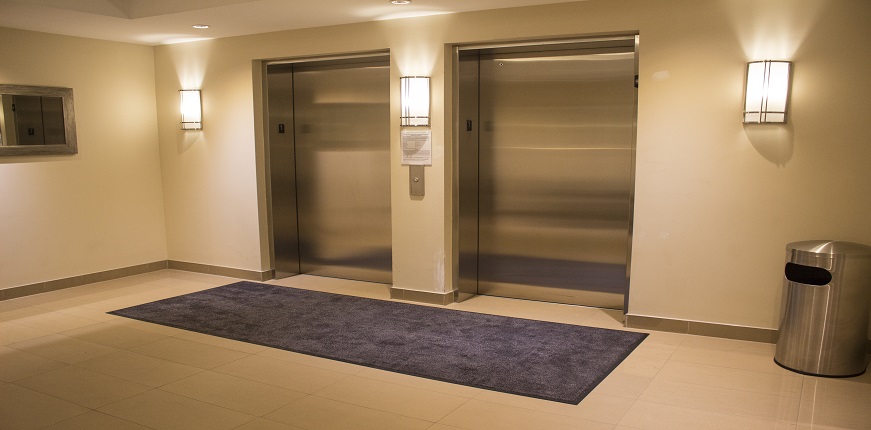
Some Info About Matting
Some Info About Matting
Mats, in one form or another, have been around since man first appeared. Early mats were made out of woven grasses, hemp, jute, leaves, or other materials that were readily available at the time – quite different than what we use now – but their basic function has always been the same; to create a barrier between us and the ground.
Today’s mats use many different materials and combinations depending on their usage, however, they largely follow a standard recipe of synthetic yarns bonded to a flexible, moisture resistant backing such as PVC or rubber.
Synthetics such as nylon or polypropylene are rugged and hold up well under heavy use, but generally aren’t particularly absorbent or easy to clean. Innovations including combining materials like natural cotton and synthetic microfiber are proving to be a potent combination in absorbency and durability.
Good secondary (entrance) mats need to do 3 things well:
Provide a safe, slip-resistant surface for pedestrians
Protect the floor beneath it from dirt, moisture and debris
Protect the floor beyond the mat by trapping and holding dirt and moisture and not let it transfer to other areas
Most mats will provide functionality on the first 2, but many fail at the third, because of the construction and/or the materials used.
A quick and simple way to find out if your mats stop dirt and moisture, is to step into a small amount of clean water – just enough to cover the sole of the shoe, then wipe the shoe on the mat 3 or 4 times. Once done, step onto a clean piece of paper. If there is still a footprint left behind on the paper, the mat is not removing dirt and moisture properly.
A good quality, effective mat will remove most or all of the moisture. Look for mats that have;
an approved slip prevention rating
have superior absorbency
use a tufted fabric construction instead of a closed-loop material (shag vs Berber)
and are also easy to clean and care for.
Regular cleaning is a must with any mat if you want to ensure its’ effectiveness. Daily vacuuming with the occasional warm water extraction using a carpet extractor will maintain your mats and will help to bring up the pile and improve its absorbency.
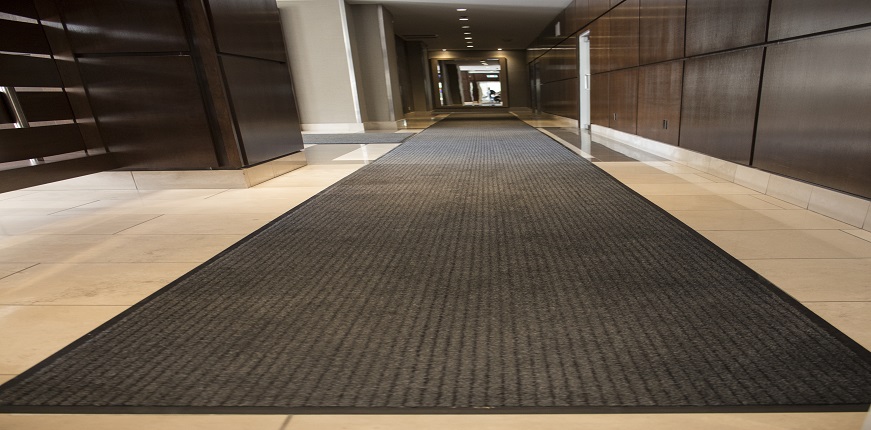
Rental Shock
Rental Shock
A few weeks ago, I noticed that my rental water heater was leaking. I dug around to find a service number on my contract and gave them a call.
While I had the contract out, I looked at what I was paying and nearly fell of my chair. I realized that for the monthly fee I had been paying for the last decade, I could have bought 4 brand new water heaters. Even if I calculated in the occasional service call, I would have saved thousands of dollars on equipment and service calls.
At our office, we get a lot of phone calls and inquiries from facility managers who are experiencing the same shock and frustration regarding their mat rental contracts and are now looking for alternative solutions.
Rental mats are convenient, no question. The nice guy shows up every couple of weeks and takes away the dirty mats, replacing it with a nice clean one. Seems like a great program…until you do the math.
Rental mats come with some serious drawbacks:
- On average, the rental program will cost about 5 times more than purchasing your mats
- Poor quality – rental mats are designed to be washed over and over, not designed to absorb moisture and dirt. This means, they’re not effective. If they’re not effective, you’re wasting money.
- You will need extra matting in bad weather, costing more money to rent additional mats.
- Rental mats that have been washed many times start to develop waves in them, which becomes a serious trip hazard, and causes them to move around on the floor.
- You’re probably already cleaning them yourself; If a new mat is delivered and you have a couple days of bad weather, you must clean/vacuum/extract them yourself until they show up again to give you a new one.
- One size doesn’t fit all – rental mat sizes are limited, so you will often have overlapping or gaps in your coverage, exposing your floor or creating slip or trip hazards.
Like the water heater, rentals seem like a good idea at first, but in the long run, they are less effective, less safe, and much more expensive than owing properly designed and fitted mats that work with your specific needs. Installed custom mats properly protect your facility and your people, look and work better, and save you money.

